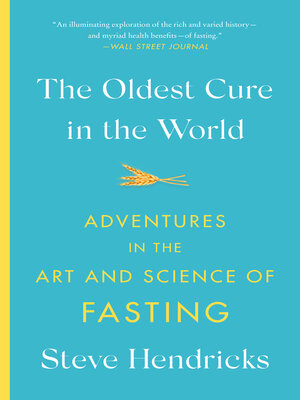The Oldest Cure in the World
ebook ∣ Adventures in the Art and Science of Fasting
By Steve Hendricks

Sign up to save your library
With an OverDrive account, you can save your favorite libraries for at-a-glance information about availability. Find out more about OverDrive accounts.
Find this title in Libby, the library reading app by OverDrive.



Search for a digital library with this title
Title found at these libraries:
| Library Name | Distance |
|---|---|
| Loading... |
"An illuminating exploration of the rich and varied history—and myriad health benefits—of fasting." —Wall Street Journal
When should we eat, and when shouldn't we? The answers to these simple questions are not what you might expect. As Steve Hendricks shows in The Oldest Cure in the World, stop eating long enough, and you'll set in motion cellular repairs that can slow aging and prevent and reverse diseases like diabetes and hypertension. Fasting has improved the lives of people with epilepsy, asthma, and arthritis, and has even protected patients from the worst of chemotherapy's side effects.
But for such an elegant and effective treatment, fasting has had a surprisingly long and fraught history. From the earliest days of humanity and the Greek fathers of medicine through Christianity's "fasting saints" and a 19th-century doctor whose stupendous 40-day fast on a New York City stage inaugurated the modern era of therapeutic fasting, Hendricks takes readers on a rich and comprehensive tour.
Threaded throughout are Hendricks's own adventures in fasting, including a stay at a luxurious fasting clinic in Germany and in a more spartan one closer to home in Northern California. This is a playful, insightful, and persuasive exploration of our bodies and when we should—and should not—feed them.
When should we eat, and when shouldn't we? The answers to these simple questions are not what you might expect. As Steve Hendricks shows in The Oldest Cure in the World, stop eating long enough, and you'll set in motion cellular repairs that can slow aging and prevent and reverse diseases like diabetes and hypertension. Fasting has improved the lives of people with epilepsy, asthma, and arthritis, and has even protected patients from the worst of chemotherapy's side effects.
But for such an elegant and effective treatment, fasting has had a surprisingly long and fraught history. From the earliest days of humanity and the Greek fathers of medicine through Christianity's "fasting saints" and a 19th-century doctor whose stupendous 40-day fast on a New York City stage inaugurated the modern era of therapeutic fasting, Hendricks takes readers on a rich and comprehensive tour.
Threaded throughout are Hendricks's own adventures in fasting, including a stay at a luxurious fasting clinic in Germany and in a more spartan one closer to home in Northern California. This is a playful, insightful, and persuasive exploration of our bodies and when we should—and should not—feed them.







